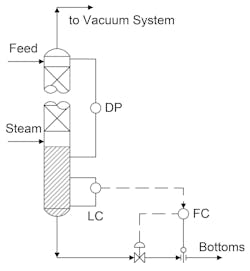Instrument Recalibration Solves Vacuum Tower Flooding
Key Takeaways
- Instrument readings that never change may be faulty.
- Accurate level measurement is critical during startup — misread levels can mask flooding and damage internals.
- Operator awareness and field checks are vital — visual verification can catch issues that instruments miss.
During startup, one vacuum tower proved especially troublesome to plant operators. The startup seemed to proceed normally. Then, the tower pressure drop rose rapidly, but the tower still seemed to work acceptably. After some time with a higher pressure drop, the tower suddenly became unstable with extremely fast additional pressure drop and dropping performance.
The tower had multiple packing beds with a pressure drop indicator across the entire set of packed beds.
All fractionation towers have a pressure drop across the tower. The pressure drop varies with liquid rate, vapor rate, system properties and tower internals. The pressure drop is closely tied to liquid inventory held on the tower internals.
For packed towers, the relationship is simple; the pressure drop is nearly identical to the equivalent liquid height held across a packed bed. The higher the pressure drop, the higher the equivalent height of clear liquid held in the packing. At some point, every packing has its limit. As the liquid builds up, the channels for vapor flow get smaller. When they become small enough, the vapor prevents the liquid from flowing down. The packing “floods.” Liquid inventory continues to accumulate and eventually may even reach the tower overhead vapor line.
The plant used the pressure drop measurement across the bed to estimate how much of the tower’s capacity was being used. If the pressure drop was lower than the control target, the operators could increase feed rates. If the pressure drop was higher than the control target, the operators were supposed to reduce feed rates.
The puzzle was that the pressure drop was running much higher than expected at feed rates below 50% of the expected rates. Additionally, the tower performance seemed to be acceptable. However, even if the plant continued to operate at the 50% rate, eventually the high-pressure drop would suddenly spike, and then all the symptoms of flooding would rapidly appear.
Figure 1 shows a simplified schematic of the system. The feed enters the tower at the top. Stripping steam enters at the bottoms. The liquid level controller cascades to the bottoms rate control. During the entire time the operators were having problems, the liquid level remained a consistent 40%. The bottoms liquid rate remained stable during the entire upset.
This last observation is curious. In general, one of the first symptoms of a flooded tower is a drop in bottoms product rate. After all, the level controller is attempting to maintain a constant level – but the increased pressure drop is a symptom of liquid not getting through the packed bed. When towers flood, the bottoms rate should drop, and it did not.
Misleading Instrumentation Masks Tower Flooding
Going out into the field when attempting to start the tower up again showed the results in Figure 2 when the pressure drop started to ramp up. The sight glass, which had the same range as the level instrument, was completely full of liquid. The real liquid level was above the level of the taps and above the DP instrument connection. However, the level instrument still showed a 40% level. The DP instrument was adding a static head of liquid to the bottoms pressure – leading to a high pressure drop reading. The level instrument for the bottoms controller was reading an incorrect level.
If the bottoms rate is too low, the liquid level continues to increase, and the measured DP plus static head continues to rise.
Eventually, the liquid level goes above the steam inlet line, and the steam starts to throw liquid around the tower. Tower operation can become unstable. In this condition, the tower was really flooding due to the steam aerating the liquid and foam rising through the packing.
If the steam inlet velocity is high enough, the steam can turn the liquid above its inlet into a hammer, dramatically damaging the tower internals. Failures of liquid level measurements at startup are one of the major causes of tower damage.
Some rapid work on recalibrating the level instrument quickly fixed the problem. Once the level was truly in the level instrument range, the tower operated normally and had the expected pressure difference.
This case illustrates several important points. First, instruments that always read the same thing are often broken. The lack of variation in liquid level was a strong indication that the level controller should be checked. Second, startup is a difficult time. Plant operators are busy finding and resolving problems. Having every board operator understand the process and typical problems that may arise can greatly ease the resolution of startup problems.
About the Author
Andrew Sloley, Plant InSites columnist
Contributing Editor
ANDREW SLOLEY is a Chemical Processing Contributing Editor.



